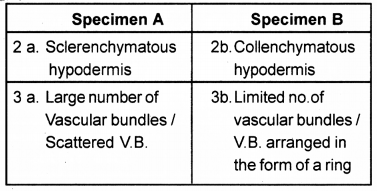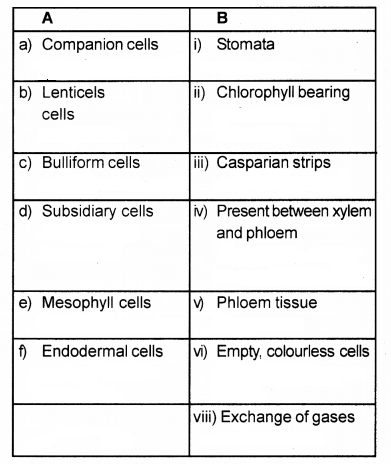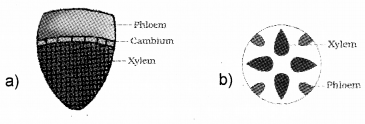Kerala Plus One Botany Chapter Wise Previous Questions Chapter 4 Anatomy of Flowering Plants
Question 1.
Grasses are capable of regeneration in spite of continuous grazing by cattle. Suggest the reason for it.(MARCH-2010)
Answer:
In Grasses the growth points (apical meristem ) are at ground level, at a point where animals like cattle are unable to rip up. So grasses are capable of regeneration.
Question 2.
a) What are bulliform cells? (MARCH-2010)
b) Mention their function.
Answer:
a) Bulliform cells are colourless fan shaped cells present in upper epidermis of grasses
b) They helps in the rolling and unrolling of the lamina and reduce water loss.
Question 3.
Suggest a method for indentification of stem and root in plants based on the arrangement of protoxylem. (SAY-2010)
Answer:
Endarch & exarch
Question 4.
In dicot stem cambium occurs between xylem and phloem and the vascular bundles are arranged in a broken ring fasion. However, dicot stem grows in diameter in a circular manner. Explain briefly how this could happen. (SAY-2010)
Answer:
Interfascicular cambium joins with intra fascicular cambium and forms ring of cambium
Question 5.
In most woody trees, epidermis breaks to form a lens shaped opening. Name this opening that permits gaseous exchange. (MARCH-2011)
Answer:
Lenticels
Question 6.
In the early morning, droplets of water can be found at the tip of grass leaves. Name the phenomenon. Can you give an explanation for this phenomenon? (MARCH-2011)
Answer:
Guttation
It is the loss of water in the form of droplets from the vien ending of the leaf.
Question 7.
For constructing furniture like table, chair etc., we usually take the dark colured central portion of wood, but not the outer light coloured region. Give reason for this, (MARCH-2011)
Answer:
Dark coloured central portion of the wood is hard and non functional part. The central part is filled with resin, gum, tannin etc.that helps to resist the attack of Micro organisms.
Question 8.
During sunny days grass leaves curl inwards and minise water loss. Why? Name the cells responsible for the curling. (SAY-2011)
Answer:
It helps to reduce surface area of leaf, thereby slows down water loss.
Bulliform cells
Question 9.
a) Teacher asked Gopi to name the layer from which root hairs and lateral roots arise respectively. (SAY-2011)
b) Differentiate the vascular bundles from the (A and B) diagrams given below.

c) Cambium is a meristem.
Answer:
a) Epidermis and pericycle
b) A- conjoint closed B-conjoint open
c) Lateral meristem
Question 10.
Analyze the given statements and correct the false statements with respect to the underlined word. (MARCH-2012)
a) In roots, vascular tissues are conjoint.
b) Cork cambium is otherwise called phelloderm
Answer:
a) Radial
b) Phellogen
Question 11.
In an anatomy lab, Ramu and Salim were taking transverse sections (T.S.) of two specimens, A and B respectively. Their observations are given in the table. Complete the table. (MARCH-2012)

Answer:

Question 12.
The following is a list of characteristic features of angiospermsand gymnosperms. Choose those char. acters that belong to gymnosperms. (SAY-2012)
a) Tracheids alone form the conducting elements in xylem.
b) Production of fruits
c) Naked seeds
d) Cones are seen
e) Flowers absent
f) Xylem mainly contains vessels
g) Double fertilization present
Answer:
Tracheids alone form the conducting tissues or elements in xylem.
Naked seeds
Cones are seen
Flowers absent
Question 13.
Dicot plants show secondary growth in their stem and root. (SAY-2012)
a) Name the meristems that causes secondary growth in vascular region and cortex.
b) Comment on the activity of this meristem.
OR
Some tissues in plants are not able to divide further
a) Suggest name of such tissues.
b) Give any three examples.
c) List the difference between epidermal tissue system of roots and leaves.
Answer:
a) Vascular cambium and phellogen or cork cambium.
b) Vascular cambium
The cells cut off towards inner side are called secondary xylem.
The cells cut off towards outer side are called secondary phloem.
Phellogen
Cells cutoff towards outside are called phellem / cork.
Cells cutoff towards inner side are called phelloderm/secondary cortex.
OR
a) Permanent tissue
b) Parenchyma, Collenchyma, Selerenchyma or Complex tissue. .
Root
Root hair present
Cuticle absent
Leaf
Stomata present
Cuticle present
Bulliform cells and
Epidermal hairs present.
Question 14.
In the anatomy lab, Eugin observed the following features in the T.S. of a plant part. (MARCH-2013)
a) Radial and polyarch xylem bundles
b) Parenchymatous (homogenous) cortex
c) Large pith
d) Epidermis with unicellular hairs
e) Pericycle
f) Endodermis with casparian strips.
i) Identify the plant part.
ii) Re-arrange the given regions from the periph-ery to the center in their correct sequence.
iii) Give an account of casparian strips.
Answer:
i) monocot root
ii) d,b,f,e,a,c
iii) It is the water-impermeable waxy material deposition consists of suberin
Question 15.
Imagine that you and your father are visiting a timber shop to buy wood for making furniture. The timber shop owner suggested rosewood. Father seeks your help to determine the age of the wood. (SAY-2013)
a) As a botany student can you help your father?
b) Justify your answer.
Answer:
a) Yes, by counting the number of Annual rings.
b) The Concentric annual ring is composed of springwood and autumn wood
Question 16.
Match the following columns A and B. (MARCH-2014)

Answer:
a) companion cells – v) phloem tissue
b) Lenticels – vii) Exchange of gases
c) Bulliform cells – vi) Empty colourless cells
d) Subsidiary cells – i) stomata
e) Mesophyll cells – ii) chlorophyll bearing cells
f) Endodermal cells – iii) casperian strips
Question 17.
Stomata are small openings present in the epidermis of leaves. The stomata are bound by guard cells. Mention the role of guard cells in stomatal mechanism. (SAY-2014)
Answer:
In day time water enters into the guard cells from the subsidiary cells and becomes turgid, as a result, its thin outer wall bulge and open while in night water moves out of the guard cell and stomata closes.
Question 18.
The following figures show two types of vascular bundles: (SAY-2014)
a) Identify the vascular bundles (A) and (B)
b) Briefly explain (A) and (B) in one or two sentences.

Answer:
a) A – Conjoint bundle
B – Radial bundle
b) Conjoint bundle – xylem and phloem are arranged in the same radii
Radial bundle – Xylem and phloem are arranged in separated radii
Question 19.
In a dicotyledonous stem, secondary growth takes place at two regions by the activity of two lateral meristems. (MARCH-2015)
a) Identify the two lateral meristems.
b) List the new tissues formed from each of these meristems.
Answer:
a) Vascular cambium and cork cambium
b) Vascular cambium gives rise to secondary xylem and secondary phloem while cork cambium give rise to phellem and phelloderm.
Question 20.

Identify the types of vascular bundles in figures 1 and 2. Write the features of each vascular bundle. (SAY-2015)
(Hint: Any two points each).
OR
Distinguish between leaf anatomy of dicot leaf and monocot leaf.
(Hint: Any three points each).
Answer:
figure 1 – closed bundle, figure 2-open bundle
Closed bundle
1 cambium absent
2 xylem vessels are round in shape
Open bundle
1 cambium is present
2 xylem vessels are polygonal in shape
OR
In dicot leaf more stomata is distributed on abaxial side than adaxial side but in monocot, stomata are equally distributed on both side In monocot leaf special epidermal cells (bulliform cells) are present while in dicot they are absent In dicot mesophyll tissue is differentiate into palisade and spongy parenchyma but in monocot mesophyll tissue is not differentiated.
Question 21.
How does periderm develop in dicot stem and replace the outer broken cortical and epidermal layers? (MARCH-2016)
OR
In dicot stem, both intrafascicular and interfascicular cambium form a ring of vascular cambium. Explain the activity of this cambial ring.
Answer:
Due to the activity of vascular cambium, girth of the stem increases.This results the breakdown of outer cortical and epidermis layers .So the new protective tissues are formed by another meristematic tissue called cork cambium or phellogen Phellogen cuts off cells on both sides. The outer cells differentiate into cork or phellem while the inner cells differentiate into secondary cortex or phelloderm. Phellogen, phellem, and phelloderm are collectively known as periderm.
OR
Thecambial ring cutoff new cells towards the inner (secondary xylem) and the outer sides (secondary phloem). The cambium is more active on the inner side than on the outer.
Amount of secondary xylem produced is more than secondary phloem. The primary and secondary phloems get gradually crushed due to the continued formation and accumulation of secondary xylem.
Question 22.
The internal anatomy of dicot and monocot stems shows many differences. Mention any four differences between their vascular bundles. (SAY-2016)
Answer:

Question 23.
In timber yielding plants, only the central part of wood is used for making furniture. Name this part and justify your answer. (SAY-2016)
Answer:
Heartwood
It is more durable, thick and resistant to attacks of microorganisms.
Question 24.
a) A tissues involve in secondary growth of dicot plants are vascular cambium and …………… (MARCH-2017)
b) Compare the formation of vascular cambium in diocot stem and dicot root.
Answer:
a) Cork cambium or phellogen
b) In dicot stems, the cells of cambium present between primary xylem and primary phloem is the intrafascicular cambium.
The cells of medullary cells, adjoining these intrafascicular cambium become meristematic and form the interfascicular cambium. Thus, a continuous ring of vascular cambium is formed. Here the formation of Cambium is partially primary and partially secondary
In dicot root, the vascular cambium is completely secondary in origin.
It originates from the tissue located just below the phloem bundles, a portion of pericycle tissue above the protoxylem forming a complete and continuous wavy ring and later it becomes circular
